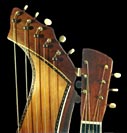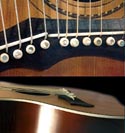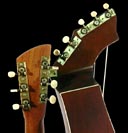 |
 |
 |
 |
 |
 |
 |
Knutsen Harp Guitar
This 3/4 scale "Double-Point" has been in the Archives for some time. It has now been fully documented after being sold and changing hands a couple of times (and now available for sale). The current owner, Duane Heilman, of Black Bear Guitars & Ukuleles (who has made some beautiful harp-ukuleles as well), has done a complete restoration on it, which he describes for us below. Here are the amazing post-restoration photos:
All images copyright Duane Heilman, unless otherwise noted
|
"Whenever I get a vintage guitar, I take a lot of time to determine if it is worth the effort to rebuild or simply hang it on the wall and call it good. I looked at this guitar for five months before I decided to go ahead with the rebuilding process. While it was hanging in my shop I had many a customer say "What is that thing?". After a brief explanation, their next question
was usually "What does it sound like?". I got to
wondering that myself. The short scale length plus other
construction details intrigued me enough to follow through with the
rebuild. The guitar was in very, very poor condition when I bought it. I took the back off (half of it was already off anyway), cleaned out the dust and dead critters and gave it a thorough look. There was not one part of this guitar that didn't need work. The top, back, sides, bindings, bracing, finish, fingerboard, etc. all had problems. I could easily write a good size article about everything that was damaged and how it was repaired but in the interest of space and time, suffice it to say, it took me most of the month of December to put it back together. It was a rewarding process and I do enjoy this kind of challenge. The following is a list of the original parts and the woods they were made of.
The new parts I changed because of necessity are as follows:
|
Duane's pre-restoration and work-in-progress comparison: |
|
Some thoughts on the playability and sound of this guitar are as follows: A steel string guitar with a small scale such as this one requires a lighter touch to play (Duane tuned it to standard -GM). For the strings I used a light gauge bronze set and replaced the top E and A string with a heavier .013 and .017. The guitar intonates better with these heavier strings and sounds fuller (Similarly, though I tuned my own 3/4 Knutsen up a third, I used correspondingly - and surprisingly - much heavier gauges than I originally calculated -GM). For the sub-bass strings I used nickel-plated .056, .056, .058, .060, and .062. They work fine to my ear. The overall sound is nice and woody with a definite harp-like quality with plenty of overtones. The sound is fuller and richer then I thought for a small scale guitar. Since all the bracing is new, the sustain is excellent. The top is nice and flat under tension and if one wanted to raise the pitch of the strings a half step or so I believe the sound would stay true and there should be no structural problems. The only thing I could not correct was the intonation on the low E string - I could not bring the bone saddle back far enough without cutting into the bridge pin area of the bridge, so the low E string becomes problematic the higher one plays up the neck." |
|
|
Knutsen Archives Inventory Number |
HGS53 |
|
|
Category |
Seattle Harp Guitars |
|
|
Body Style |
"Double Point" |
|
|
Current or last known owner |
anonymous > Duane Heilman > |
|
|
Year (approx) |
ca. 1906-1908 | |
|
Label |
C. Knutsen Sole Patentee of the Harp guitar with 11 strings. The five extra bass strings are tuned to D, C, B, A and G one octave lower than regular pitch. | |
| Label Code | SE1 | |
|
Courses / Strings |
11 course: 6 strings on neck, 5 bass | |
|
Frets |
straight | |
| Scale length | 19-1/4" | |
| Neck Joint | no heel | |
|
Woods |
Top |
cedar |
|
Back & Sides |
Honduran mahogany | |
|
Neck |
Spanish cedar | |
|
Fingerboard |
dyed pearwood | |
|
Bridge |
dyed walnut | |
| Headstock veneer | walnut | |
|
Binding, trim |
Top |
fancy wood purfling |
|
Back |
ivoroid | |
|
Fingerboard |
ivoroid | |
|
Headstock(s) |
none | |
| Soundhole | wood purfling | |
|
Inlay |
fancy pearl fret markers | |
|
Pickguard |
none |
|
|
Comments |
||
[Biographical]
[Instruments]
[Historical
Photos]
[Credits]
[FAQ]
[Bibliography]
[Updates]
[Links]
[Contact]
[Home
(Knutsen Archives)] [Home
(Harpguitars.net)]
All Site Contents Copyright © Gregg Miner, 2002, 2003, 2004, 2005,2006,2007,2008,2009. All Rights Reserved.
Copyright and Fair Use of material and use of images: See Copyright and Fair Use policy.